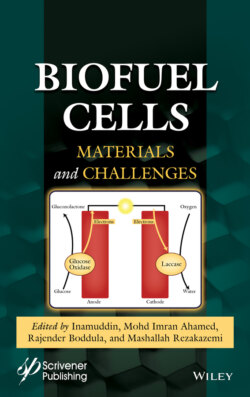Читать книгу Biofuel Cells - Группа авторов - Страница 13
1.1 Introduction: Generalities of the Bioelectrocatalysis
ОглавлениеElectrochemical catalysis or electrocatalysis is used to describe charge transfer-based reactions occurring on an electrode. This term was employed for first time in 1936 by Santos and Schimickler [1]. The electrocatalysis is focused on increasing the reaction rate of an electrochemical process (oxidation/reduction), involving a dissociative chemisorption or a reaction step on an electrode surface and thus, the electrocatalysis depends on the ad/desorption of reactants and products, and on the formation of an electrochemical double layer. An electrocatalytic cycle is composed of three stages: 1) mass transport of electroactive species from bulk to the interface, 2) the electrocatalytic reaction, and 3) transport of products to bulk. Additionally, stage 2 involves the adsorption of reactants, the electron transfer, and the desorption of products. Consequently, the art of electrocatalysis consists of identifying the barriers of an electrochemical reaction to adjust the properties of the electrochemical interface (electrode and/or solution) with the aim of remove or at least, decrease the energy barriers (activation energies).
The practical role of electrocatalysis implies the science of designing the electrochemical interface properties. Hence, the morphological and electronic properties of the electrocatalyst, together with the electrolyte characteristics, become important to analyze. On the other hand, the activation energy of electrocatalytic reactions also depends on the electrode potential, thus enabling a fine control of the reactions. Consequently, electrocatalysis focuses on minimizing electrode overpotential, and increasing the reaction rate via the decrease of activation energies for a specific reaction.
The relation between electrocatalysis and microorganisms was presented in 1910 when a yeast was used as catalyst in a fuel cell. In the 60s microbial fuel cells (MFC) were used to exploit human waste from spacecraft, and only about 40 years later, the MFCs gained worldwide attention due to the use of industrial wastewater as fuel [2]. Entire microbial cells, organelles and biological molecules have been utilized as catalyst in biofuel cells. The molecules for energy conversion in living eukaryotic cells are utilized as biocatalyst and as model reactions. The reactions are complex and involve the action of nucleotides nicotinamide adenine dinucleotide (NAD) and flavin adenine dinucleotide (FAD). The nucleotides in the cell are reduced to NADH and FADH2 by protons coming from a chain of oxidation reactions belonging to the microbial catabolic metabolism. The cyclic oxidation and reduction of nucleotides enables the transport of charge in the mitochondria and thus in the microbial cell. The energy pathways in prokaryote cells involve a chain of transmembrane enzymatic proteins. The c-type cytochromes in the outer cell membrane enable direct contact cell-electrode and research in molecular biology shows that cytochromes are responsible for extracellular electron transfer (EET).
The reactions occurring in the living cells involve different catalytic proteins or enzymes; thus charge transfer through biological molecules has required many years of investigation. Enzymes can act in the electrolyte, or be immobilized at the electrode, and electron transfer achieved via either mediated or direct form. The contact of the enzyme with the substrate is achieved via physical or covalent adsorption. The type of contact is a function of the location of the active site in the enzyme, which can be in the periphery or in the core of the catalytic protein. The electrode material for immobilization of the bioelectrocatalyst is one of the main issues. Thus, the intrinsic properties of the electrode such as porosity and conductivity must be improved via doping, template construction or addition of nanomaterials. Another concern in bioelectrocatalysis is the lifetime of the enzymatic electrodes, which are very sensitive to environmental conditions. Plenty of strategies using polymers have been proposed, including encapsulation, cross-linking, anchoring, and self-assembly with the aim of improving the electron transfer between the enzyme and the electrode. This process can be explained by different mechanisms like percolation though immobile redox centers, collision of mobile centers, and conduction through a conjugated backbone. The direct transfer occurs via electron tunneling from the active site in the enzyme and the electrode.
In the following sections, reactions of general interest in cells catalyzed by enzymes and microorganisms are described in the first instance. The next section focuses on advances in electrode material development, as well as enzyme immobilization and bacterial biofilm preparation strategies. Finally, in the last sections the phenomena that occur in the transfer of electrons at the enzymatic and bacterial level are described, and two cases of application of bioelectrocatalysis are presented.
